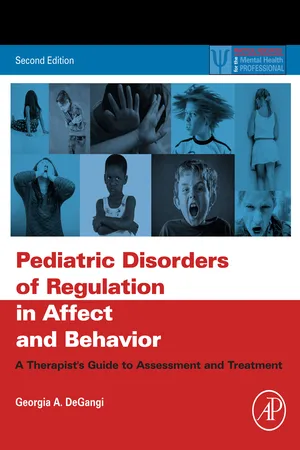Abstract
Parents and professionals have often puzzled over the importance of early regulatory problems in young children and their impact on the developing child. Most normal young infants show irregularities in negotiating sleep cycles, digestion, and self-calming which usually resolve around 6 months of age. However, some infants and children show persistent problems in sleep, self-consoling, feeding, and mood regulation (i.e., fussiness, irritability) which don’t resolve and may continue through life. As the infant grows into the toddler and childhood years, problems often become more evident. Difficulties with self-consoling, sleep, eating, attention, sensory processing, intolerance for change, a hyper-alert state of arousal, and mood regulation (i.e., irritability, anxiety, and depression) often occur. Children experiencing these symptoms have been termed as regulatory disordered (Greenspan, 1989, 1992; Zero to Three, 1994). When the regulatory disorder persists over time, the child may become diagnosed with disorders including bipolar or mood disorder, anxiety, obsessive–compulsive disorder, Asperger’s syndrome, eating or sleep disorder, attention deficit disorder, and sometimes, posttraumatic stress disorder. Since children with these behaviors are commonly observed in clinical practice, it is important to understand the symptoms underlying the regulatory disorder and how early problems with self-regulation impact later development, adaptive behaviors, and interpersonal relationships.
Parents and professionals have often puzzled over the importance of early regulatory problems in young children and their impact on the developing child. Most normal young infants show irregularities in negotiating sleep cycles, digestion, and self-calming which usually resolve around 6 months of age. However, some infants and children show persistent problems in sleep, self-consoling, feeding, and mood regulation (i.e., fussiness, irritability) which don’t resolve and may continue through life. As the infant grows into the toddler and childhood years, problems often become more evident. Difficulties with self-consoling, sleep, eating, attention, sensory processing, intolerance for change, a hyper-alert state of arousal, and mood regulation (i.e., irritability, anxiety, and depression) often occur. Children experiencing these symptoms have been termed as regulatory disordered (Greenspan, 1989, 1992; Zero to Three, 1994). When the regulatory disorder persists over time, the child may become diagnosed with disorders including bipolar or mood disorder, anxiety, obsessive–compulsive disorder, Asperger’s syndrome, eating or sleep disorder, attention deficit disorder, and sometimes, posttraumatic stress disorder. Since children with these behaviors are commonly observed in clinical practice, it is important to understand the symptoms underlying the regulatory disorder and how early problems with self-regulation impact later development, adaptive behaviors, and interpersonal relationships.
Poor self-regulation is a process deficit that impacts the person’s everyday functioning and interpersonal relationships. Oftentimes problems of self-regulation are life-long and have roots in the person’s early childhood development. As problems with self-regulation become entrenched, the person struggles with self-soothing and mood regulation. It impacts the capacity to modulate arousal for sustained attention, to be motivated for purposeful activities, to process and tolerate a range of sensory stimulation, and to tolerate change and handle everyday stress. Frequently the child struggles with coping skills, impulsivity, and self-control, especially as they grow older. As a result of the regulatory disorder, the child is apt to have difficulty developing a clear sense of identity, purpose in life, and self-efficacy.
An overview of regulatory processes in infants and children is presented and a conceptual model of self-regulation is proposed. The symptoms that constitute a regulatory disorder in children are described. The outcomes of preschool children who had regulatory disorders during infancy are described and how early symptoms may lead to these outcomes. Finally, the different types of regulatory disorders that have been proposed by the Diagnostic Classification: 0–3 are described. Case examples are presented to depict the symptomatology of the different subtypes. Checklists are provided to assist the clinician in diagnosing children with problems of self-regulation. The Infant-Child Symptom Checklist can be used in helping parents and clinicians to understand the child’s regulatory profile. In addition, a version of the Functional Emotional Observation Scale is presented for use by therapists to better understand the child’s capacity for self-regulation and to serve as a guide for treatment.
1. The concept of self-regulation and its development
1.1. Overview
The early regulation of arousal and physiological state is critical for successful adaptation to the environment. The development of homeostasis is important in the modulation of physiological states including sleep–wake cycles, hunger and satiety, body temperature, and states of arousal and alertness. It is needed for mastery of sensory functions, self-calming, and emotional responsivity. It is also important for regulation of attentional capacities (Als, Lester, Tronick, & Brazelton, 1982; Brazelton, Koslowski, & Main, 1974; Field, 1981; Sroufe, 1979, 2005; Sroufe, Coffino, & Carlson, 2010; Tronick, 1989; Tronick & Beeghly, 2011). The foundations of self-regulation lie in the infant’s capacity to develop homeostasis in the first few months of life when the infant learns to take interest in the world while simultaneously regulating arousal and responses to sensory stimulation (Greenspan, 1992; Lachmann & Beebe, 1997). As the infant matures, self-regulation depends on the capacity to read and give gestural and vocal signals, to internalize everyday routines, and to respond contingently to expectations from others (Kopp, 1987, 1989; Tronick, 1989). Although there are individual differences, the child must learn to adapt to changing family and parental expectations to master self-regulation.
Self-regulatory mechanisms develop and refine early in the person’s life. Some of the important milestones include the formation of affective relationships and attachments, reciprocal communication and language, the use of self and others to control internal states, an understanding of causal relationship...

